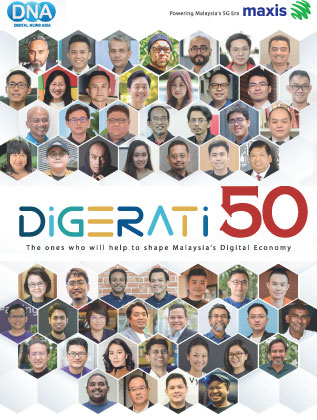Customer analytics still lacking in banks: Teradata
By Edwin Yapp May 31, 2017
- Banks still lag in using customer data intelligently; mindset change needed
- Data scientists need intuition, business sense, data gathering, communication skills
THE financial services industry is still struggling to process customer data in a way that would be useful for them to glean intelligence from customers and better serve them, according to an industry expert.
Speaking at Teradata’s Innovation day in Kuala Lumpur recently, Stephen Brobst, chief technology officer (CTO) of Teradata, said that banks always have customers’ data but they have historically not used it well.
“Banks have always been ‘data companies,’ he said, referring to how they collect vast amounts of financial data from their customers. “But they have not done a good a job at getting [the data] out to the hands of the consumers.”
The Miamisburg, Ohio-based software vendor is known for building databases, data warehouses and analytics software, and is publicly traded on the New York Stock Exchange. It counts amongst its competitors the likes of Oracle Corp, IBM, Microsoft Corp.
Brobst argued that in a digital world, traditional companies must transform themselves into data companies as the age-old methods they use in serving consumers are being surpassed by others who use data in the most innovative of ways.
“There are three choices in the new [digital] economy,” he said during his keynote. “All companies are either already data companies, will become data companies, or will cease to be relevant.”
He gave an example of how Philips NV now produces electric toothbrushes that collect information about consumer habits while brushing their teeth. This, he said, was how the Dutch consumer electronics giant was adding value to its customers – not just by creating a great product but also by providing value to customers with the data it has of their customers.
Brobst said previously, Philips did not know who their customers were as retailers sell their products to end users. But now they know who their customers are through the collection of data, he added.
He also said more forward-thinking financial services players have begun treating data in a more valuable way, citing banks such as the UK’s Lloyds Bank, Australia’s WestPac and the US’ Wells Fargo as having done so.
“All companies are doing this, regardless of what industry you’re in. If they are not doing so, it would be to their detriment.”
Not all do
When asked why certain banks, particularly some in Malaysia, are still using age-old methods of reaching their customers such as telemarketing over the phone or via electronic mailers – both of which annoy many customers – Brobst conceded that some banks are still stuck in the old ways, although he said some banks are beginning to change their mindset.
Arguing that many banks today still operate on an old data paradigm, which is based on batch processing and not on real-time processing, Brobst said, “The way they think about [outbound telemarketing and electronic mailers] is that it’s an old-school, incremental cost-of-doing-business model,” he said in an interview with Digital News Asia (DNA) after his keynote.
“Take for example an outbound phone call. The incremental cost of a phone call to a particular customer that might buy a product is relatively low. A customer might buy it or he might not but the expected value is very large [as far as the bank is concerned]. So therefore, banks continue using this method.
“The problem is that banks aren’t listening to what customers really want. Their financial model is broken because this old model does not account for the negative sentiments of the call or email, and if banks call or email too often, customers will block you or add you to their spam list.
“So when a bank has something really useful to say, the customer won’t listen. Banks have not accounted for this cost – the cost of potentially losing the right to talk to you. Banks will have to look at the lost opportunity cost and also the possibility that the customer will churn [leave the bank for another].”
Quizzed as to what must be done to fix this, Brobst said banks need to change their thinking to use a “champion-challenger-type” model.
“You have to find a champion within the bank who is willing to break away from how business is done and challenge the existing models,” he argued.
“And if a bank is successful in doing that and is able come up with a very different customer experience, don’t do it all at once. It may need to test a market to try its new ideas as Malaysia is a risk-averse market.
“Banks will need to try something on a small scale such as small pilots that show value. Only after that, can they quickly ramp up,” Brobst suggested.
Teradata Malaysia country manager Saqib Sabah concurred, noting that the verticals that have seen some traction as data driven companies are telcos and some banks in Malaysia. Other sectors that are turning towards using more data in their operations are in the utilities, oil and gas and the public sector.
“We’ve not yet finished exploring the full potential of the market as customers take time to recognise what these pilots are, their value and in Malaysia, customers are slow to make a first move. Malaysia really is a fast follower, rather than a leader.”
Data scientist traits
On a related development, Brobst said Malaysia has the requisite talent for data scientists but the challenge for the country is that there are not enough of them.
Asked what must be done to further grow this sector, Brobst said the Malaysian government already has good plans to augment the number of data scientists in Malaysia through the Asean Data Analytics Exchange (ADAX), which aims to produce 20,000 data professionals (10% of them data scientists) by 2020.
Separately, Teradata has also inked a strategic partnership to collaborate on education and research in an effort to cultivate the next generation of data science professionals and experts in Malaysia with Multimedia University Malaysia.
Brobst said these are good first steps but acknowledged that it will take time to ramp up the supply to meet the demand in the coming years.
Saqib added that universities such as MMU are hungry to push these programmes and he believes that more professionals would be produced eventually.
To a question of what makes a good data scientist, Brobst said that the individual would firstly need to have the curiosity to dive into the data head first – that is to say that everything must be data-driven and proven by data.
“He or she also needs to have good intuition, a good business sense and a will that will explore where the data leads him or her,” Brobst said.
Complementing this would be data-gathering skills, that is to know how to find the data and how to design experiments to obtain data when it is not available, he said.
Other skills needed are the ability to understand causality versus correlation, analytics modeling, the use of historical data to predict the future without overfitting the data and finally, communication skills to explain the results of data exploration without using math jargon, Brobst said.
Related Stories:
Transformation, customer experience go hand in hand: Adobe
Multimedia University and Teradata ink MoU to equip students with big data analytics skills
Malaysia's big data framework rolls out
For more technology news and the latest updates, follow us on Facebook,Twitter or LinkedIn.



